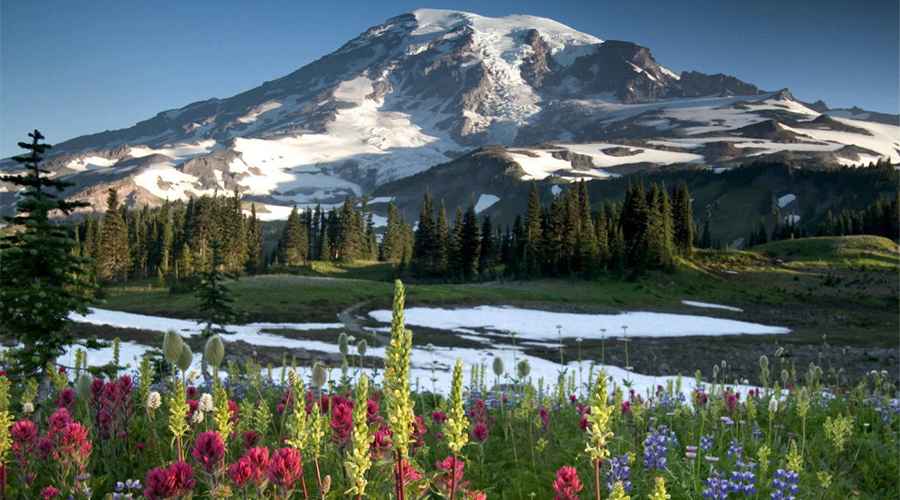Mount Rainier is a majestic and iconic peak located in Washington State, USA. Its towering presence and fascinating natural features make it a captivating subject for nature lovers, hikers, and scientists alike. Here are five interesting facts about Mount Rainier that highlight its uniqueness, rich biodiversity, and geological significance:
1. Tallest and Most Glaciated Peak in the Cascades
At an elevation of 14,410 feet (4,392 meters), Mount Rainier is the tallest mountain in Washington and the entire Cascade Range, making it a dominant feature on the skyline. But beyond height, Mount Rainier is the most heavily glaciated peak in the contiguous United States. It boasts 28 named glaciers, along with numerous smaller ice patches, covering over 35 square miles (91 square kilometers) of its surface.
These glaciers are massive rivers of ice, some reaching depths up to 750 feet, slowly shaping the mountain’s rugged valleys and feeding important river systems below. The sheer scale of this glacial coverage is remarkable, especially considering it surpasses all other peaks outside Alaska in lower 48 states.
2. An Active and Dangerous Volcano
Mount Rainier is not just a towering mountain; it is a stratovolcano composed of layers of lava and volcanic ash laid down over hundreds of thousands of years. Classified as an active volcano, its last significant eruptive activity occurred about 1,000 years ago, with minor activity recorded in the 19th century. The volcano is closely monitored by scientists because it poses significant hazards.
In the event of an eruption, the combination of volcanic activity and melting glaciers could produce massive lahars—fast-moving mudflows—that could threaten nearby towns and cities, including those in the Seattle-Tacoma metropolitan area. Due to this risk, Mount Rainier is listed as one of the “Decade” volcanoes, a designation by the United Nations highlighting volcanoes that require special monitoring and research to mitigate disaster risks.
3. Rich Biodiversity Across Varied Habitats
The park encompassing Mount Rainier supports a diverse array of wildlife and plant species across its many habitats. Within Mount Rainier National Park, scientists have documented over 65 mammal species, including black bears, mountain goats, elk, and Douglas squirrels. Birdwatchers can spot more than 180 bird species, including Steller’s jays and ravens.
The park is also home to amphibians like the Pacific tree frog and reptiles such as garter snakes. This rich variety stems from the mountain’s wide elevational range and microclimates—from dense old-growth forests in the foothills to subalpine meadows bursting with wildflowers during the brief summer months. Such biodiversity reflects an ecosystem that is both varied and vital.
4. A Long History of Human Connection and Natural Preservation
Mount Rainier has been part of indigenous cultural heritage for thousands of years before it became a national park. Native American tribes such as the Puyallup, Nisqually, and Yakama peoples traditionally regarded the mountain as sacred, calling it names like “Tahoma,” meaning “the mountain that touches the sky.” Archaeological evidence shows these tribes hunted, gathered, and performed spiritual rituals around the mountain for at least 9,000 years.
In 1899, Mount Rainier became the United States’ fifth national park, preserving over 236,000 acres of wilderness. Today, the park features rustic historic buildings designed almost a century ago and emphasizes preservation of the mountain’s ecosystems and natural beauty for future generations.
5. Extraordinary Mountaineering Challenges and Records
Mount Rainier is a major destination for climbers, with roughly 10,000 summiting attempts each year. While its trails attract many hikers, ascending to the summit requires technical mountaineering skills due to the extensive snow, glaciers, and crevasses that cover the peak. It is considered a formidable climb demanding preparation and caution.
In an extraordinary feat of aviation history, in 1951 Lieutenant John W. Hodgkin of the U.S. Air Force famously landed a small plane on the summit at 14,410 feet, setting a record for the highest altitude landing, though the stunt ended abruptly with a crash. Mount Rainier continues to challenge adventurers and thrill seekers with its imposing presence and natural obstacles.
Conclusion
Mount Rainier is much more than just a scenic mountain; it is a colossal natural wonder with layers of scientific, cultural, and recreational significance. Its stature as the tallest and most glaciated peak in the Lower 48, combined with its active volcano status, makes it both awe-inspiring and potentially dangerous. The diversity of wildlife and plants embraces a range of habitats, while its deep connection with indigenous communities and long-standing national park status preserve its heritage. For adventurers and explorers, Mount Rainier offers both challenge and history, a truly fascinating peak to behold and understand.
These five fascinating facts illustrate why Mount Rainier captures the imagination of so many visitors and professionals worldwide, continuing to be a symbol of natural beauty, power, and resilience.



